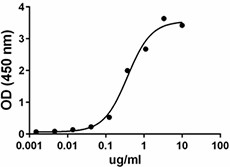- Regulatory Status
- RUO
- Other Names
- CD274, Programmed cell death 1 ligand 1 (PD-L1), B7 homolog 1 (B7h1)

-

Immobilized human PD-L1 binds human PD-1 in a dose dependent manner.
| Cat # | Size | Price | Quantity Check Availability | ||
|---|---|---|---|---|---|
| 762504 | 20 µg | $89.00 | |||
| 762506 | 100 µg | $218.00 | |||
This product is not available for shipping outside of the United States.
PD-L1 is a type I transmembrane protein of 290 amino acids, and it is a member of the B7 family. Human PD-L1 has 70% amino acid identity to its mouse orthologue. Binding of PD-L1 to its receptor PD-1 leads to the inhibition of T cell receptor–mediated lymphocyte proliferation and cytokine secretion. PD-L1 induces IL-10 production in T cells stimulated with low levels of anti-CD3. PD-L1/PD-1 interaction suppresses immune responses against autoantigens and tumors and plays an important role in the maintenance of peripheral immune tolerance. Disruption of the PD-L1 gene leads to up-regulated T cell responses and the generation of self-reactive T cells. Antibodies against PD-1 or PD-L1 leads to increased antitumor immunity. PD-L1 has an important role in conferring fetomaternal tolerance in an allogeneic pregnancy model; antibodies against PD-L1 lead to a breakdown in maternal tolerance to the fetus. PD-L1 shares its receptor with PD-L2 (CD273, B7-DC). PD-L2 has a more limited expression than PD-L1, being expressed on activated macrophages and dendritic cells. PD-L1 is expressed in many tumors, and the interaction with its receptor activates signaling pathways that inhibit T-cell activity and therefore the antitumor immune response. Antibodies targeting PD-1 or PD-L1 block the PD-1 pathway and reactivate T cell activity.
Product Details
- Source
- Human B7-H1, amino acids (Phe19-Arg238) (Accession# NP_054862) was expressed in CHO cells. Human IgG-Fc is in the carboxy-terminus.
- Molecular Mass
- The 453 amino acid recombinant protein has a predicted molecular mass of approximately 51.2 kD. The predicted N-terminal amino acid is Phe.
- Purity
- >98% as determined by Coomassie stained SDS-PAGE and HPLC analyses.
- Formulation
- Lyophilized from 10mM Sodium Phosphate + 25 mM NaCl, pH 7.6.
- Endotoxin Level
- Less than 0.1 ng per µg of protein (<1.0 EU/µg), as determined by the LAL method.
- Storage & Handling
- Unopened vial can be stored at -20°C or -70°C for twelve months. For maximum results, quick spin vial prior to opening. Reconstitute in water to a concentration of 0.1 - 1.0 mg/ml. Do not vortex. It is recommended to further dilute in a buffer, such as 5% Trehalose, and store working aliquots at -20°C to -70°C. Avoid repeated freeze/thaw cycles.
- Activity
- Immobilized human PD-L1 binds human PD-1 in a dose dependent manner. The ED50 = 0.2 - 0.8 µg/ml.
- Recommended Usage
-
Bioassay
- Product Citations
-
Antigen Details
- Structure
- Dimer.
- Distribution
-
APC, monocytes, dendritic cells, expressed in nonlymphoid tissues, and stromal cell.
- Function
- Enhances CD28-independent T-helper cell function, suppresses immune responses against autoantigens, and participates in fetomaternal tolerance.
- Interaction
- Antigen-stimulated T and B cells, regulatory T cells, follicular T and B cells, dendritic cells, and monocytes.
- Ligand/Receptor
- PD-1 (CD279).
- Bioactivity
- Immobilized human PD-L1 binds its receptor PD-1.
- Cell Type
- Embryonic Stem Cells
- Biology Area
- Cancer Biomarkers, Costimulatory Molecules, Immunology, Stem Cells
- Molecular Family
- Adhesion Molecules, CD Molecules, Immune Checkpoint Receptors, Soluble Receptors
- Antigen References
-
1. Dong H, et al. 1999. Nat. Med. 5:1365.
2. Freeman GJ, et al. 2000. J. Exp. Med. 192:1027.
3. Latchman Y, et al. 2001. Nat. Immunol. 2:261.
4. Latchman YE, et al. 2004. Proc. Natl. Acad. Sci. USA 101:10691.
5. Guleria I, et al. 2005. J. Exp. Med. 202:231.
6. Lin DY, et al. 2008. Proc. Natl. Acad. Sci. USA 105:3011.
7. Dai S, et al. 2014. Cell Immunol. 290:72.
8. Melero I, et al. 2015. Nat. Rev. Cancer 15:457. - Gene ID
- 29126 View all products for this Gene ID
- UniProt
- View information about B7-H1 on UniProt.org
